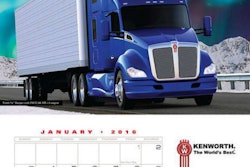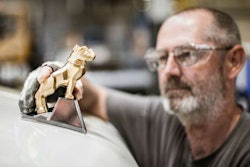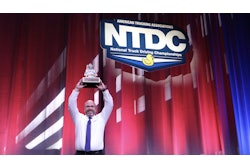On page 203 of the Patrick Foster’s new 208-page book, “International Trucks: The Complete History” (Motorbooks) is a photo of the company’s new Project Horizon concept truck, of which the author says, “It literally is the truck of the future.”
Patrick Foster’s new books examines the life of International Harvester/NavistarBut, it’s not too much of an overstatement to suggest that at several times throughout the 103-year history of the company – now known as Navistar International – its future looked dim if not downright bleak.
Foster, the author of 21 books and columns in both “Hemmings Classic Cars” and “Old Cars Weekly,” details International’s/Navistar’s history in this lavishly illustrated volume that became available late last month. From the time Cyrus McCormick Jr. merged his McCormick Harvesting Machine with the Deering Harvester Company (and several other firms) to today, this mammoth Midwest manufacturer created products that were essential to many Americans, especially farmers and trucking companies.
Along the way, it grew to have, at one point, about 100,000 employees and a product line so expansive that it included farm equipment, all manner of trucks, home appliances, lawn mowers and even rifles for the U.S. military. But still, according to Foster, the company faced any number of financial issues, just as it has more recently.
But, through it all, says Foster, the company maintained an image that spoke to many Americans, himself included.
Author Patrick Foster“I always thought of International as a really tough truck,” said Foster. “It’s a very durable brand, but not as well known in some parts of the country. In farming communities you see a lot more of them.”
While International began life as a farm products company, it eventually became a truck maker and much more. In his book, Foster writes:
“Despite an initial focus on farm requirements, International grew to become one of the premier truck manufacturers in the industry … Over the years, International offered the most comprehensive lineup of trucks in America and was usually among the top sellers in the business. Probably no other company has built as large a range of trucks for as many years as International.”
The company’s first truck was the Auto Wagon, which appeared in 1908 and was aimed at farmers. In 1909 International led the small, but growing, truck market.
It would, according to Foster, go on to build some of the greatest trucks to navigate America’s highways. But, the company would also miss a major opportunity, one that might have made it a different – even more successful – company.
Foster said the American truck market changed in the 1960s. Up until then, he said, companies sold trucks to farmers and businessmen. But, Americans started buying pickups as second vehicles or even their first one.
While International had a sound dealer network in rural farm communities, it had none in urban and suburban communities where these new buyers lived, according to Foster. Because of this, it missed an opportunity to penetrate that market.
Foster suggests that had IH joined forces with Studebaker, which enjoyed success in the late 1950s with its Lark, both companies could have thrived. He said Studebaker had 2,000 dealers in places IH didn’t, and IH had pickup trucks, and Studebaker didn’t.
Foster suggests that had such a merger happened, IH would not have had to exit the light truck market and Studebaker could have benefitted as well.
Still, he said IH manufactured some outstanding highway and work trucks, not to mention a variety of military vehicles. To Foster, the IH KB series was what he called “the iconic” IH.
While it was a leader in the production of trucks and agricultural equipment, International expanded, manufacturing and selling an array of products.
Foster explained:
“Your local International distributor would come out to farms and he would be driving his International pickup truck and he’d have an International refrigerator strapped in the back and he would be towing an International cornpicker to show off to the farmer. Because the way farm communities are, the farmer would often buy all three because he trusted his International dealer.
“And then they went into the Cub Cadet tractors. They were a major supplier of the Garand M-1 rifle. They branched out into a lot of things. They were a very big company for a very long time. A huge company.”
But, like many huge American companies, International had its struggles, especially after World War II.
Said Foster, “It comes down to two factors: union and management. When a company gets to be a certain size, if it’s a giant company like International or General Motors, I think union workers think its an unlimited gold mine, and we can just keep going back to the well for more, and more and more. That drove up International’s labor costs tremendously high.”
After World War II, IH had 18 to 20 different unions to deal with, said Foster.
Each union would go around to members of the other unions and say, “If you join us we’ll get you higher pay, we’ll get you better benefits, we’ll get you more days off.”
Foster said, “Then the only way to get the more money was to strike. Strikes just crippled their profitability and when they were settled, they crippled their cost structure. They took a shellacking on it.”
But, Foster said those who ran the company had to shoulder some of the blame as well.
“The other part was management’s fault in thinking, ‘OK, we’re a big company and we can get ourselves into debt and it doesn’t matter. We’re International, we’re never going to go out of business.’ And, it was a little bit on both sides. People got a little over-confident and took their eye off the ball; didn’t pay attention to the main aspects of business, which is you have to do to build a good product for your customer. And, you have to be profitable. Everything else is secondary to that.
“It was unfortunate, in particular in the agricultural department. They let their costs and their capacities get way, way too large to the point where they couldn’t turn a profit on it.”
Foster said there was what he called “a telling moment” at a stockholder’s meeting in the 1970s. One person in the audience pointed out that the company’s financial services division generated half the company’s profits for the year.
“Guys in an office writing loans for tractors and trucks made more money for the company than the thousands of people building those trucks and tractors,” said Foster. “That showed that their priorities were mixed up.”
But the truest of tipping points came in 1979-1980. Unions at International went on strike again and it was a long, bitter strike. When it was settled in 1980, Foster said, “the economy had been flushed down the toilet. And, I think the company still hasn’t recovered from that.”
Many of those who went on strike saw their jobs eliminated forever and the company just kept shrinking and narrowing its focus on fewer and fewer trucks.
Chapter Eight of Foster’s book is titled, “The New Navistar: 1986-2000 and it begins, “On January 7, 1986, the old, beloved International Harvester Company name was laid to rest as the company assumed its new corporate name: Navistar International Company. A made-up name, it combined Navi-, as in to navigate with star, a word long used by International in names such as Paystar, Loadstar and Fleetstar.”
Foster completes the story of the evolution of not just a major truck maker, but also one of the great American manufacturers by bringing Navistar into the 21st Century.
The last 15 years have not been easy for the company. Like others, it has been plagued by a rollercoasting global economy. Its fortunes have waxed and waned and it has enjoyed product successes and some sour ones.
In the end, Foster concludes his book by saying:
“Navistar has had its time on the anvil, getting hammered but forging a new, stronger company as a result. With outstanding products, a determined executive team, and a cadre of loyal employees, the outlook for this great old company is good. Cyrus McCormick and Edward Johnston would both be proud.”
Note: About the time “International Trucks: The Complete History” hit bookstore shelves, the company released its most recent financial numbers. They showed a fourth quarter 2015 net loss of $50 million, an improvement of $22 million from the fourth quarter of 2014. Revenues in the quarter were $2.5 billion, a 17 percent drop compared to fourth quarter 2014. For full-year 2015 results, Navistar reported a net loss of $184 million against a net loss of $619 million for fiscal year 2014.












